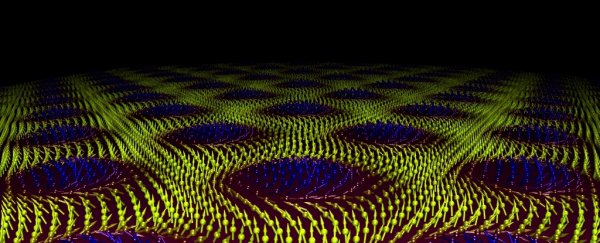A search through a mountain of data from the Large Hadron Collider for particles called magnetic monopoles has once again come up empty handed.
That doesn't yet completely rule out the possibility of these hypothetical objects. But it does tell us that if they exist, they might be extraordinarily massive particles that are beyond our ability to create.
Magnetic monopoles are often explained as being a particle that represents a single pole of a magnet - something nobody has ever seen so far.
If you slice a magnet in half, you still get an object with a north pole and a south pole. No matter how tiny you make the thing, you won't get an isolated pole.
Not that this stops physicists from looking: the story of the magnetic monopole dates back to the equations of the theoretical physicist James Clerk Maxwell.
He mathematically showed that we could swap electric for magnetic fields and not see any real difference - in other words, the two were symmetrical.
That only works for their fields, though. Electrical currents have charges, which are points that exist in a vector, meaning the current flows in a direction.
If we have magnetic fields that are symmetrical with electric fields, why not magnetic points that also flow along a vector? Finding one would tell us a lot about their electrical twin as well.
So the search was on for magnetic points that were the equivalent of a charge - the magnetic monopole.
Not everybody is convinced they exist. Last year, physicists argued that the symmetry between electricity and magnetism is broken at a deep, fundamental level. Still, for many optimists, the search continues.
"A lot of people think they should exist," says particle physicist James Pinfold from the University of Alberta in Edmonton, Canada.
He and his team have just trawled through a pile of data from the Monopole and Exotics Detector at the LHC (MoEDAL). And they came up with nothing.
Their research was published recently on the pre-print website arXiv.org, which means we need to be cautious in not reading too deeply until it gets published in a peer-reviewed journal.
But the fact they had six times the information as previous efforts involving MoEDAL, and also took into consideration monopoles with a different kind of spin to previous analyses, shows how much ground has been covered.
In some ways this is a good thing – the research further narrows down where the monopole might be hiding. Crashing protons together at ridiculous speeds is just one way we might be able to make magnetic monopoles.
Another team of physicists from Imperial College London took a slightly different approach to searching for the elusive particles, publishing their results in the journal Physical Review Letters last December.
Part of the problem as they saw it was if monopoles were being produced inside particle colliders, there was every chance they'd be strongly stuck together.
What was needed was another way to narrow down the kinds of properties they might have, and then compare those with MoEDAL's results.
To do this they considered how magnetic monopoles might appear inside intense, hot magnetic fields, just like those surrounding a type of neutron star called a magnetar.
If their mass was small enough, their magnetic charge would affect the star's magnetic field.
Of course, even the strength of the monopole's charge is hypothetical at the moment, but based on a few reasonable assumptions they calculated we could expect the particle's mass to be more than about the third of that of a proton.
That's not exactly tiny. And if the actual charge is heavier than the smallest one imaginable, that mass goes up.
Either way we look at it, physicists are needing to consider two possibilities; either the magnetic monopole is a myth, and the fractured symmetry between electricity and magnetism is a fundamental part of nature; or this thing is big.
It's possible we just might need bigger colliders. It's also possible magnetic monopoles are so heavy, only something as monumental as a Big Bang could produce them, leaving us to hunt for relics.
Only one thing is for certain – the hunt continues.
The study can be found on arXiv.org.
